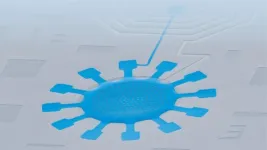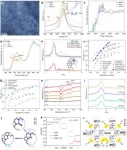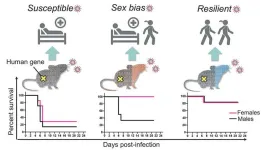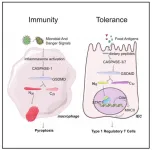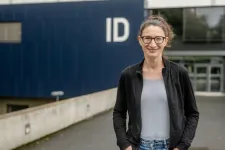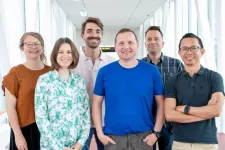(Press-News.org)
Over the past decade, scientists have made tremendous progress in generating quantum phenomena in mechanical systems. What seemed impossible only fifteen years ago has now become a reality, as researchers successfully create quantum states in macroscopic mechanical objects.
By coupling these mechanical oscillators to light photons - known as “optomechanical systems”-, scientists have been able to cool them down to their lowest energy level close to the quantum limit, “squeeze them” to reduce their vibrations even further, and entangle them with each other. These advancements have opened up new opportunities in quantum sensing, compact storage in quantum computing, fundamental tests of quantum gravity, and even in the search for dark matter.
In order to efficiently operate optomechanical systems in the quantum regime, scientists face a dilemma. On one hand, the mechanical oscillators must be properly isolated from their environment to minimize energy loss; on the other hand, they must be well-coupled to other physical systems such as electromagnetic resonators to control them.
Striking this balance requires maximizing the oscillators' quantum state lifetime that is impacted by their environment’s thermal fluctuations and oscillators frequency instabilities – what is known in the field as “decoherence”. This is a persistent challenge across various systems, from the gigantic mirrors used in gravitational wave detectors to tiny trapped particles in high vacuum. Compared to other technologies like superconducting qubits or ion traps, today's opto- and electro-mechanical systems still show higher decoherence rates.
Now, scientists at the laboratory of Tobias J. Kippenberg at EPFL have tackled the problem by developing a superconducting circuit optomechanical platform that shows ultra-low quantum decoherence while maintaining large optomechanical coupling that results in a high-fidelity quantum control. The work is recently published in Nature Physics.
“In simple words, we demonstrated the longest quantum state lifetime ever achieved in a mechanical oscillator, which can be used as a quantum storage component in quantum computing and communication systems,” says Amir Youssefi, a PhD student who led the project. “This is a big achievement and impacts a wide range of audiences in quantum physics, electrical engineering, and mechanical engineering.”
The key element of the breakthrough is a “vacuum-gap drumhead capacitor”, a vibrating element made of a thin aluminum film suspended over a trench in a silicon substrate. The capacitor serves as the vibrating component of the oscillator and also forms a resonant microwave circuit.
Through a novel nanofabrication technique, the team significantly reduced mechanical losses in the drumhead resonator, achieving an unprecedented thermal decoherence rate of only 20 Hz, equivalent to a quantum state lifetime of 7.7 milliseconds – the longest ever achieved in a mechanical oscillator.
The remarkable decrease in thermally induced decoherence allowed the researchers to use optomechanical cooling technique, resulting in an impressive 93% fidelity of the quantum state occupation in the ground state. Additionally, the team achieved mechanical squeezing below the zero-point-fluctuation of motion, with a value of -2.7 dB.
“This level of control allows us to observe the free evolution of mechanical squeezed states preserving its quantum behavior for an extended period of 2 milliseconds, thanks to the exceptionally low pure dephasing rate of only 0.09 Hz in the mechanical oscillator,” says Shingo Kono, who contributed to the research.
“Such ultra-low quantum decoherence not only increases the fidelity of quantum control and measurement of macroscopic mechanical systems, but will equally benefit interfacing with superconducting qubits and places the system in a parameter regime suitable for tests of quantum gravity,” says Mahdi Chegnizadeh, another member of the research team “The considerably longer storage time compared to superconducting qubits makes the platform a perfect candidate for quantum-storage applications.”
The device was fabricated in the Center of MicroNanoTechnology (CMi) at EPFL.
END
As a crucial part of Carbon Capture, Utilization, and Storage (CCUS) technology, CO2 reduction reaction (CO2RR) to carbon-based fuels and chemicals presents broad application prospects in renewable energy storage and CO2 negative emission. Recently, a team led by Prof. SONG Li and Associate Researcher HE Qun from the National Synchrotron Radiation Laboratory of the University of Science and Technology of China (USTC) of the Chinese Academy of Sciences (CAS) put forth a novel understanding of the mechanism of CO2RR on the nickel (Ni) single-atomic sites. Their study, titled "Asymmetric ...
Researchers at The Jackson Laboratory have created a panel of genetically diverse mice that accurately model the highly variable human response to SARS-CoV-2 infection. Together with collaborators at NIH’s Rocky Mountain Laboratories, the team uncovered differences in the innate immune and regulated proinflammatory responses, the timing and strength of which are associated with disease severity. Moving forward, the diverse mouse strains will allow scientists to model patient variation in COVID-19 ...
A research team led by Prof. ZHU Shu from the University of Science and Technology of China (USTC) of the Chinese Academy of Sciences (CAS) illustrated the role of Gasdermin D (GSDMD) protein in immunity tolerance to food in the small intestine. The study was published in Cell.
GSDMD, an executioner protein of cell pyroptosis, has garnered widespread attention. When cells are stimulated by pathogen-associated molecular patterns (PAMPs) or damage-associated molecular patterns (DAMPs), the signaling receptors within the cells activate caspase-1/4/5/8/11, leading to the N-terminal cleavage of GSDMD and ...
A team led by Prof. LIU Guilin and Prof. HE Zhicheng from the University of Science and Technology of China (USTC) of the Chinese Academy of Sciences (CAS) discovered superbubble pairs generated by quasar-driven outflows of three red quasars for the first time. This study was published in Science Advances.
The observed number of massive galaxies is significantly lower than the prediction of the current galaxy evolution theory, thus certain mechanism is needed to suppress star formation and modulate the growth of the galaxy. To bridge the gap between theory and observation, an outflow mechanism where a galaxy nucleus drives a massive amount of gas into intergalactic ...
Prof. REN Baohua and his team from the School of Earth and Space Sciences, the University of Science and Technology of China (USTC) of the Chinese Academy of Sciences (CAS), uncovered the connection between Arctic daily warming and the equator region as well as Atlantic storms. The series of studies have been published in npj Climate and Atmospheric Science, Environmental Research Letters, and Advances in Atmospheric Sciences.
As one of the coldest places where the average winter temperature is -30℃, the Arctic temperature has reached the melting point several times, for instance, in late December 2015 and 2022. Those Artic daily warming events ...
A research team led by Professor WANG Jian, the deputy chief designer of the Wide Field Survey Telescope(WFST)and a faculty member of the State Key Laboratory of Nuclear Detection and Nuclear Electronics of the School of Physics, University of Science and Technology of China (USTC) of the Chinese Academy of Sciences(CAS), carried out the key technology of the main focus camera. The results were published in IEEE Transactions on Instrumentation and Measurement in July ...
The research team led by Prof. LIU Xianwei from the Department of Environmental Science and Engineering of University of Science and Technology of China (USTC) of the Chinese Academy of Science (CAS) has made progress in the dynamic imaging of interfacial electrochemistry. The results were published in Nature Communications under the title of "Dynamic Imaging of Interfacial Electrochemistry on Single Ag Nanowires by Azimuth-modulated Plasmonic Scattering ...
A research team led by Prof. WU Dong from the University of Science and Technology of China (USTC) of the Chinese Academy of Sciences (CAS) proposed a femtosecond laser 2-in-1 writing multi-material processing strategy to fabricate micromachined joints composed of temperature-sensitive hydrogels and metal nanoparticles, and developed multi-jointed humanoid micromachines with multiple deformation modes (>10). The results were published in Nature Communications.
In recent years, femtosecond laser two-photon polymerization, as a true three-dimensional fabrication technique ...
Lasers are an essential tool for materials processing. They can be used to cut, weld and remove material. A special kind of lasers known as femtosecond lasers can be used to create high-precision microstructures, such as those needed for smartphone displays and automotive technology. Professor Clara Saraceno from Ruhr University Bochum aims to introduce a cheaper and more efficient laser technology to the market. To this end, she is receiving a proof-of-concept grant amounting to 150,000 euros from the European Research ...
A new study presents a promising treatment method for so-called fusion-driven cancers, which are currently often difficult to cure. These fusion-driven cancers are caused by an error in cell division that creates a fusion of different genes. This fusion causes the cancer and drives the uncontrolled cell growth.
Using the so-called molecular scissors CRISPR/Cas9, researchers from Aarhus University have developed a gene therapy that can stop cell division in a subtype of the aggressive blood cancer acute myeloid leukaemia (AML).
The study has just been published in the scientific journal Leukemia. Even though the ...
